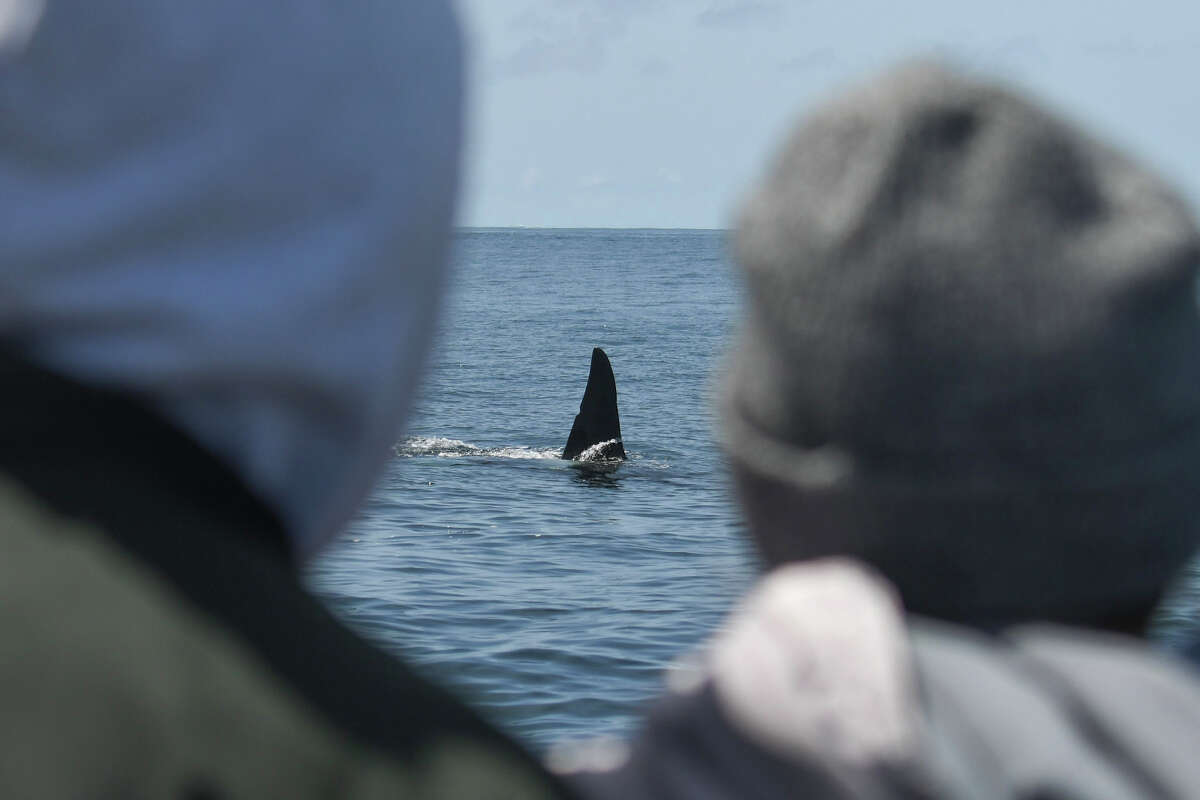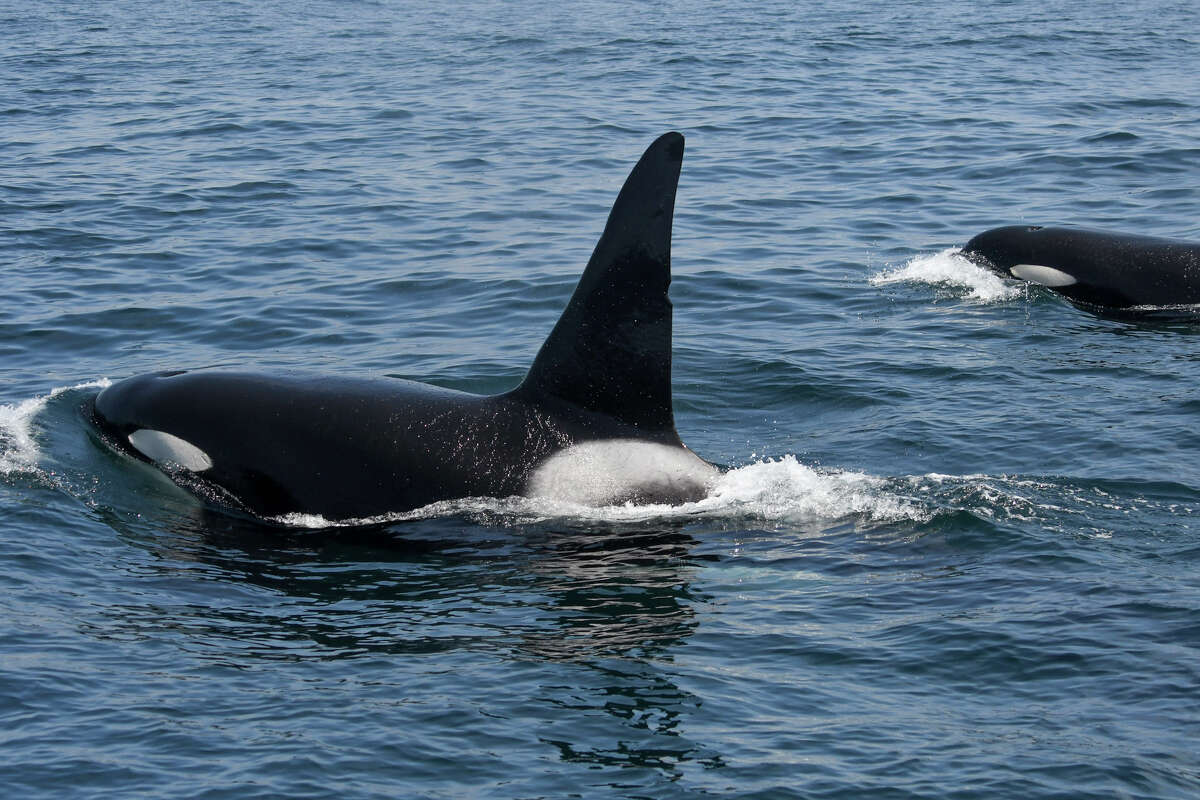Last month, Michael Pierson went on a whale-watching tour with the Oceanic Society from the coast of San Francisco to the Farallon Islands. He didn’t know what he might see.
The naturalist wasn’t seeing as many whales as usual, so on May 7, an unusually clear day with small waves and a light breeze, he and the captain decided to change their normal route and go to the islands from the south instead of the west.
Pierson said that the choice “immediately paid off.” As soon as the boat got to the continental shelf, the people on board saw a blue whale. The whale seemed a little scared of them and left quickly. They were amazed as albatrosses flew above them and humpback whales ate krill near them.
Then Pierson saw a black fin sticking out of the water that was 6 feet tall.
“Right away I knew what it was,” he said. “I yelled out, ‘Orca!’”
It took a while for the boat to catch up to the killer whales, or orcas, who were moving quickly through the water. Once the animals saw the boat, it looked like they slowed down and came closer to check it out.
When Pierson saw how many whales there were, he counted up to 24. There were seven or eight matrilines, which are groups of a mother and her young, and several adult males, which can grow up to 30 feet long and weigh up to 10 tons. People on the boat squealed with delight as tiny calves swam right up to it, some coming within 10 to 15 feet.
“We were completely stopped, and they were surrounding us,” Pierson said. “It was hard to tell who was watching who.”
He said that Oceanic Society naturalists don’t see orcas as often near the Farallon Islands as they do in other parts of California. The non-profit ecotourism group gets data for scientists and environmentalists. It goes on trips every weekend from April to November, but only sees two to four orcas on average during that time.
“Just seeing them is always really exciting, but seeing such a large grouping was what made it a one-of-a-kind experience,” Pierson said.
In total, the whale watchers watched the orcas closely for about 40 minutes, until the animals moved on. Later that day, when Pierson and some other experts were going over photos from the trip, he noticed something even stranger: many of the matrilines had never been seen before.
Alisa Schulman-Janiger, the lead research biologist for the California Killer Whale Project and Monterey Bay Whale Watch, was able to identify each whale. She has been studying this species for decades and has been keeping track of six different groups. In March, people saw a group of whales kill two gray whales in Monterey Bay. Five of these whales were part of that group.
“It was so interesting because there were so many of them and they were all different,” Schulman-Janiger said. “You’d think that if you saw one of those families, you’d see another one, but it was a real mix of whales that weren’t related and don’t usually hang out together.”
It’s hard to say how often people see orcas near the Farallon Islands because so much of the information rests on when a boat is in the area, if the people on board see a whale, and if the weather is good enough to watch and film them.
Schulman-Janiger said, “We only get a small glimpse into their lives.” “In the spring, when the babies are traveling north with their mothers, we usually see bigger groups in Monterey Bay. It hasn’t never happened before, but it’s rare.”Last month, Michael Pierson went on a whale-watching tour with the Oceanic Society from the coast of San Francisco to the Farallon Islands. He didn’t know what he might see.
The naturalist wasn’t seeing as many whales as usual, so on May 7, an unusually clear day with small waves and a light breeze, he and the captain decided to change their normal route and go to the islands from the south instead of the west.
Pierson said that the choice “immediately paid off.” As soon as the boat got to the continental shelf, the people on board saw a blue whale. The whale seemed a little scared of them and left quickly. They were amazed as albatrosses flew above them and humpback whales ate krill near them.
Then Pierson saw a black fin sticking out of the water that was 6 feet tall.
“Right away I knew what it was,” he said. “I yelled out, ‘Orca!’”
It took a while for the boat to catch up to the killer whales, or orcas, who were moving quickly through the water. Once the animals saw the boat, it looked like they slowed down and came closer to check it out.
When Pierson saw how many whales there were, he counted up to 24. There were seven or eight matrilines, which are groups of a mother and her young, and several adult males, which can grow up to 30 feet long and weigh up to 10 tons. People on the boat squealed with delight as tiny calves swam right up to it, some coming within 10 to 15 feet.
“We were completely stopped, and they were surrounding us,” Pierson said. “It was hard to tell who was watching who.”
He said that Oceanic Society naturalists don’t see orcas as often near the Farallon Islands as they do in other parts of California. The non-profit ecotourism group gets data for scientists and environmentalists. It goes on trips every weekend from April to November, but only sees two to four orcas on average during that time.
“Just seeing them is always really exciting, but seeing such a large grouping was what made it a one-of-a-kind experience,” Pierson said.
In total, the whale watchers watched the orcas closely for about 40 minutes, until the animals moved on. Later that day, when Pierson and some other experts were going over photos from the trip, he noticed something even stranger: many of the matrilines had never been seen before.
Alisa Schulman-Janiger, the lead research biologist for the California Killer Whale Project and Monterey Bay Whale Watch, was able to identify each whale. She has been studying this species for decades and has been keeping track of six different groups. In March, people saw a group of whales kill two gray whales in Monterey Bay. Five of these whales were part of that group.
“It was so interesting because there were so many of them and they were all different,” Schulman-Janiger said. “You’d think that if you saw one of those families, you’d see another one, but it was a real mix of whales that weren’t related and don’t usually hang out together.”
It’s hard to say how often people see orcas near the Farallon Islands because so much of the information rests on when a boat is in the area, if the people on board see a whale, and if the weather is good enough to watch and film them.
Schulman-Janiger said, “We only get a small glimpse into their lives.” “In the spring, when the babies are traveling north with their mothers, we usually see bigger groups in Monterey Bay. It hasn’t never happened before, but it’s rare.”
Also, no one knows why the whales were in the area because they were only seen moving and not mating or hunting. Orcas hunt by ambush, so they need it to be quiet so they can sneak up on their prey. They usually move in small groups of three to seven people. The peak of the gray whale migration season does happen in the last week of May. This led Schulman-Janiger to think that the orcas could have been looking for a mother and calf to hunt, but it would be unusual for such a big group to do so. She thought, though, that the pod might have come together because they heard something strange in the distance or were just hanging out. She said that some whales are more curious than others and like to look for new places to check out.
She said, “We know they make long-lasting friendships and connections, but we don’t know what they get out of it.”
Orcas don’t migrate, so it’s hard to predict where they will be. However, Schulman-Janiger thinks it’s “extremely unlikely” that these six groups will be seen together in the future.
“They’re typically seen in different areas, and we don’t believe they’re closely related,” she said. “I don’t expect to see this again.”
An unusually large pod of orcas for Northern California — roughly two dozen — was spotted by a whale watching tour off the coast of San Francisco, possibly gathering to celebrate a successful hunt for sea lions or seals. https://t.co/GWealpFwkH pic.twitter.com/in4Bt43qrn
— ABC News (@ABC) June 8, 2023
Also, no one knows why the whales were in the area because they were only seen moving and not mating or hunting. Orcas hunt by ambush, so they need it to be quiet so they can sneak up on their prey. They usually move in small groups of three to seven people. The peak of the gray whale migration season does happen in the last week of May. This led Schulman-Janiger to think that the orcas could have been looking for a mother and calf to hunt, but it would be unusual for such a big group to do so. She thought, though, that the pod might have come together because they heard something strange in the distance or were just hanging out. She said that some whales are more curious than others and like to look for new places to check out.
She said, “We know they make long-lasting friendships and connections, but we don’t know what they get out of it.”
Orcas don’t migrate, so it’s hard to predict where they will be. However, Schulman-Janiger thinks it’s “extremely unlikely” that these six groups will be seen together in the future.
“They’re typically seen in different areas, and we don’t believe they’re closely related,” she said. “I don’t expect to see this again.”







